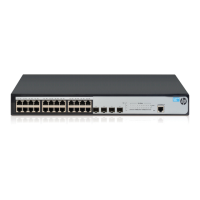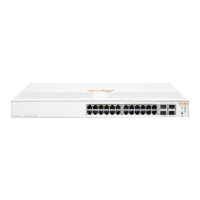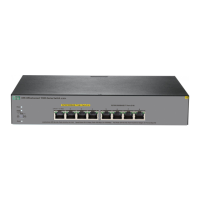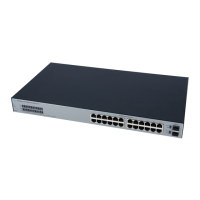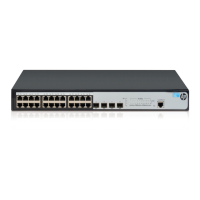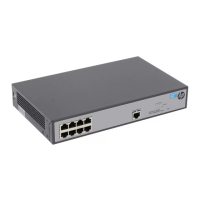202
• Forwarding—The port receives and sends BPDUs, learns MAC addresses, and forwards user
traffic.
• Learning—The port receives and sends BPDUs, learns MAC addresses, but does not forward user
traffic. Learning is an intermediate port state.
• Discarding—The port receives and sends BPDUs, but does not learn MAC addresses or forward
user traffic.
NOTE:
hen in different MSTIs, a port can be in different states.
A port state is not exclusively associated with a port role. Table 58 lists the port states that each port role
supports. (A check mark [√] indicates that the port supports this state, while a dash [—] indicates that the
port does not support this state.)
Table 58 Port states that different port roles support
Port role (right)
Port state (below)
Alternate port Backup port
Forwarding √ √ — —
Learning √ √ — —
Discarding √ √ √ √
How MSTP works
MSTP divides an entire Layer 2 network into multiple MST regions, which are connected by a calculated
CST. Inside an MST region, multiple spanning trees, called MSTIs, are calculated. Among these MSTIs,
MSTI 0 is the CIST.
Similar to RSTP, MSTP uses configuration BPDUs to calculate spanning trees. An important difference is
that an MSTP BPDU carries the MSTP configuration of the bridge from which the BPDU is sent.
CIST calculation
The calculation of a CIST tree is also the process of configuration BPDU comparison. During this process,
the device with the highest priority is elected as the root bridge of the CIST. MSTP generates an IST within
each MST region through calculation. At the same time, MSTP regards each MST region as a single
device and generates a CST among these MST regions through calculation. The CST and ISTs constitute
the CIST of the entire network.
MSTI calculation
Within an MST region, MSTP generates different MSTIs for different VLANs based on the
VLAN-to-instance mappings. For each spanning tree, MSTP performs a separate calculation process,
which is similar to spanning tree calculation in STP/RSTP. For more information, see "How STP works."
In MSTP, a VLAN packet is forwarded along the following paths:
• Within an MST region, the packet is forwarded along the corresponding MSTI.
• Between two MST regions, the packet is forwarded along the CST.

